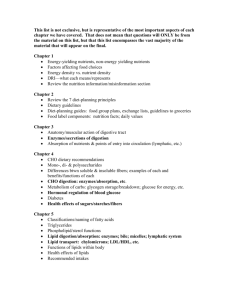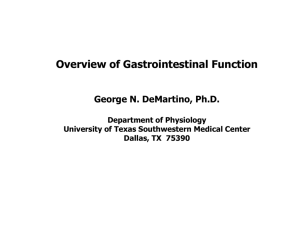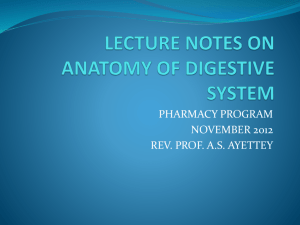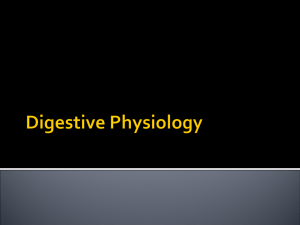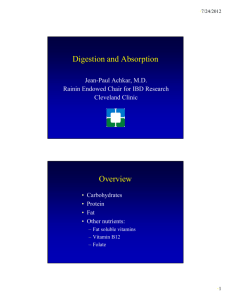Chapter 21: The Digestive System
advertisement
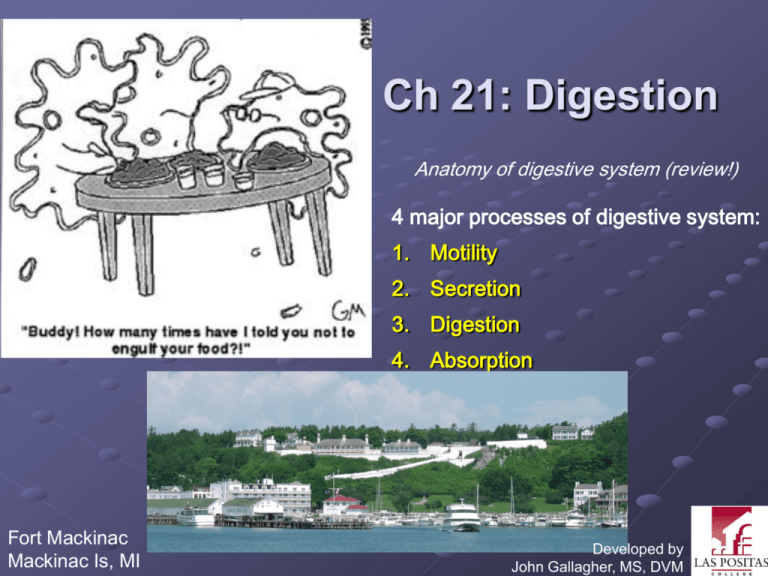
Ch 21: Digestion Anatomy of digestive system (review!) 4 major processes of digestive system: 1. Motility 2. Secretion 3. Digestion 4. Absorption Fort Mackinac Mackinac Is, MI Developed by John Gallagher, MS, DVM GI Anatomy Fig 21-1 Motility 2 purposes: Forward movement of food Mechanical mixing GI smooth muscles contract spontaneously Pacemaker cells, (Interstitial Cells of Cajal), connected by gap junctions, generate slow wave potentials APs spread throughout longitudinal muscles (gap junctions) wave of contraction Like cardiac muscle, Ca2+ can regulate contraction strength 1. 2. 3. 4. Motility Secretion Digestion Absorption Different Patterns of Contraction Tonic Contractions Sustained contraction, usually in the stomach Phasic Contractions Peristaltic contractions progressive waves moving along segments of longitudinal layer forward propulsion circular layer contracts proximal to bolus Especially esophagus Segmental contractions alternate contraction & relaxation lead to mixing A side effect of narcotics Fig 21-4 Secretion 1. 2. 3. 4. Motility Secretion Digestion Absorption 9 L of fluid pass through the GIT (only 2 L from food & drink) Secretion and Reabsorption important Ions and water; similar to renal mechanisms Saliva Hydrochloric Acid (Parietal Cells) Bicarbonate (enzyme necessary ?) Enzymes (zymogens) Mucus (Goblet cells) Bile (bile salts – function?) Net Fluid Balance in GI system Fig 21-5 Regulation of GIT p 689 ANS Parasympathetic (R & R) Sympathetic Emotional (cephalic reflexes) E.g., smell of food ENS (Enteric Nervous System) Self-contained (intrinsic) GI peptides can have regulatory role as hormones or paracrines E.g., Gastrin, CCK Table 21-1 Digestion Overview Mechanical breakdown and mixing aid enzymatic breakdown Chewing Tonic contractions, esp. stomach Enzymatic breakdown converts macromolecules into absorbable units Bile emulsifies fats Optimal pH of enzymes indicates location of activity 1. 2. 3. 4. Motility Secretion Digestion Absorption Absorption Overview Most nutrient absorption takes place in ? Fats absorbed into lacteals Everything else absorbed into portal vein Alcohol & aspirin across gastric epithelium Additional: H2O, ions & some vitamins absorbed in ________________ Mechanisms analogous to renal absorption 1. 2. 3. 4. Motility Secretion Digestion Absorption CHO Digestion & Absorption ~50% of calories in average American diet Starch (polysaccharide) and sucrose (disaccharide) Cellulose (roughage) not digestible Enzymes: amylases, disaccharidases (maltase, sucrase, lactase) Absorbed only as monosaccharides (glucose, fructose) Small intestine Fig 21-14 Protein Digestion and Absorption Variable digestibility 30-60% of protein not from diet First digestion in Stomach by HCl Proteases secreted as proenzymes Pepsin(-ogen), trypsin, etc. Absorption of single a.a. and di- and tripeptides Specific receptors required for larger chains May serve as allergens (Ch 24) DDAVP Lipid (fat) Digestion Mostly triglycerides in diet Cholesterol, Fat-soluble vitamins, others. Combination with bile salts creates an emulsion Colipase and lipase allow formation of small micelles Absorption of fat via diffusion across apical CM Chylomicrons in the cell are absorbed into lacteals See fig 21-19 Other Stuff Water soluble vitamins— mediated transport Fat soluble vits. via absorption Water,Ions and Minerals Various locations and methods, e.g, diffusion, carrier proteins Nucleic Acids Colon Cancer 2nd largest cause of cancer deaths Cellulose (indigestible) = fiber, roughage Significance of “roughage” in diet?? Phases of Digestion/Absorption 1. 2. 3. 4. Cephalic Gastric Intestinal Defecation 1. 2. 3. 4. Cephalic Gastric Intestinal Defecation •Anticipation •Salivation •Mastication •Mechanical digestion •Deglutition •Peristalsis in esophagus Reflux Esophagitis = Heartburn = GERD Lower esophageal sphincter dysfunction Why reflux against gravity? See p.700 GERD, cont’d 1. Intrapleural pressure during inspiration Wall of esophagus expands Subatmospheric pressure in esophageal lumen sucks acidic stomach contents into esophagus 1. 2. 3. 4. Cephalic Gastric Intestinal Defecation •Storage •Relaxation or contraction as needed. •Digestion •HCl (Parietal cells) •Pepsin (Chief cells) •Mechanical •Immune Protection •Ingested pathogens •Respiratory mucus 1. 2. 3. 4. Cephalic Gastric Intestinal – Chyme (ingesta) enters small intestine Defecation o Neutralization of HCl o NaHCO3 from pancreas o Running Problem: Peptic Ulcer and antacids, including H2 antagonists and proton pump inhibitors o Pancreatic enzymes o Digest protein, CHO o Bile acids o Emulsion of Fat o Absorption of H2O 1. 2. 3. 4. Cephalic Gastric Intestinal Defecation Bacterial fermentation of CHO and proteins Lactate, some vitamins are digested and/or absorbed More H2O absorption Osmotic diarrhea vs. secretory diarrhea Osmotic-solutes prevent H2O reabsorption Lactose intolerance Secretory- bacterial toxins ("flush out' pathogens) Defecation Reflex Fig 21-21 Lactose Intolerance Clinical focus p. 707 Lactose = glucose + galactose Lactase only found in juvenile mammals Adaptive (dominant) mutation in populations with dairy-based cultures Lactose intolerance in 95% of Native Americans, 90% of Asian Americans 70% of African Americans 50% of Mexican Americans


